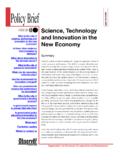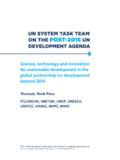Transcription of Highlights from the OECD Science, Technology and Industry ...
1 February 2018. Highlights from the OECD Science, Technology and Industry scoreboard 2017 - The Digital Transformation: European Union Science, innovation and the digital revolution Machine-to-machine (M2M) sim card penetration, a key component of the Internet of Things . (IoT) infrastructure and the development of the European Digital Single Market, more than doubled over the past five years in the European Union [ scoreboard fig. ]. The EU area accounted for 12% of AI-related inventions patented in the 5 top IP offices during 2010-15, down from 19% in 2000-05 [fig. ]. The EU area maintained its global share of high quality scientific production, accounting for about a third of the world's top 10% most-cited scientific publications, ahead of the United States and China [fig.]
2 See below]. The average excellence of EU research, at about 12%, is lower than in the United States, which maintains its status as the country with the highest domestic share of high-quality scientific research (14%) [fig. 1. 12]. In 2015, domestic R&D expenditure was USD 386 billion PPP in the EU area - behind both the United States (USD 503 billion PPP) and China (USD 409 billion PPP) [fig. ]. Over the past decade, government expenditure on R&D (GERD) as a percentage of GDP has remained relatively stable in the EU area as a whole [ ] as has the level of government R&D budgets [fig. - see below] although there is notable variation across EU countries. Growth, jobs and the digital transformation Data on the deployment of industrial robot technologies show that the robot intensity the industrial stock of robots divided by manufacturing value added, has increased considerably for some EU countries between 2005 and 2015, especially in the Slovak Republic, the Czech Republic and Slovenia [fig.
3 - see below]. From 2010 to 2016, the EU area experienced net employment gains of over million jobs [fig. ]. Net gains were the highest in Professional, scientific, technical and other business services, followed by Public administration, education, health and other services. Net losses were recorded in the Agriculture, forestry and fishing and Construction sectors. In 2014, of jobs in the EU business sector were used in production to meet final demand in non-EU economies [fig. ], up from in 1995. Combining the value added generated by ICT industries with the non-ICT Industry value added embodied in global demand for ICT goods and services can be considered as a first step towards defining an extended ICT footprint . In 2011, the EU area accounted for 23% of the world's extended ICT footprint, slightly ahead of the United States [fig.
4 ]. Evidence suggests that medium and high-skilled workers benefit most from firm-based training. On average, between 30% (the Russian Federation and Greece) and 76% (the Netherlands, Denmark and Finland) of workers receive some training from their employers. Among the EU. countries included in the analysis, high-skilled workers account for between 25% (Austria) and 56% (Belgium) of those receiving training [fig. ]. OECD 2018. Innovation today - Taking action During 2012-15, 7% of IP5 patents with inventors from the EU area, involved women inventors;. lower than comparable shares for the United States and Canada (10%) [fig. ]. Experimental indicators of international mobility of scientific authors (based on bibliometric data) reveal that the EU area became a net attractor for a short period in 2008-09, but registered a very significant deficit after 2011.
5 Over the last 15 years, almost 36 000 more scientific authors left the EU area than entered. This is explained in part by the return mobility of individuals who arrived as students before becoming published scientists [fig. - see below]. ICT skills play a significant role in explaining the gender wage gap. Estimates suggest that returns on ICT tasks are larger for women than for men, especially in Ireland, Canada, Korea and Estonia. Training women and endowing them with additional ICT skills may therefore contribute to increasing their wages and help to bridge the gender wage gap [fig. ]. Figure Economies with the largest volume of top-cited scientific publications, 2005 and 2016. As a percentage of the world's top 10% most-cited publications Global share, 2005 Global share, 2016.
6 %. 40. 30. 20. 10. 0. EU28 USA CHN GBR DEU ITA FRA JPN CAN AUS IND ESP KOR NLD CHE. Statlink 2 Source: OECD Science, Technology and Industry scoreboard 2017 : The Digital Transformation, OECD Publishing, Paris, Figure Top robot-intensive economies and BRICS, 2005 and 2015. Industrial robot stock over manufacturing value added, millions USD, current values 2015 2005. USD million Top robot-intensive economies USD million BRICS. Statlink 2 Source: OECD Science, Technology and Industry scoreboard 2017 : The Digital Transformation, OECD Publishing, Paris, Figure Government R&D budgets, selected economies, 2008-16. Constant price index (USD PPP 2008 = 100). % Argentina Australia Germany Korea Mexico Russian Federation Turkey 180. 160. 140. 120. 100.
7 80. % Canada France United Kingdom Italy Japan United States EU28. 120. 110. 100. 90. 80. 70. Statlink 2 Source: OECD Science, Technology and Industry scoreboard 2017 : The Digital Transformation, OECD Publishing, Paris, Figure International net flows of scientific authors, selected economies, 2002-16. Difference between annual fractional inflows and outflows, as a percentage of total flows 2002-06 2006-11 2011-16 Net flows, full period (right-hand scale). % Flows 100 15 000. 80. 10 000. 60. 40. 5 000. 20. 0 0. -20. -5 000. -40. -60. -10 000. -80. -100 -15 000. -35 888. Statlink 2 Source: OECD Science, Technology and Industry scoreboard 2017 : The Digital Transformation, OECD Publishing, Paris OECD 20. The OECD Science, Technology and Industry scoreboard 2017 : The Digital Transformation The 2017 edition of the scoreboard contains over 200 indicators showing how the digital transformation affects science, innovation, the economy, and the way people work and live.
8 The aim of the STI scoreboard is not to rank countries or develop composite indicators. Instead, its objective is to provide policy makers and analysts with the means to compare economies with others of a similar size or with a similar structure, and monitor progress towards desired national or supranational policy goals. It draws on OECD efforts to build data infrastructure to link actors, outcomes and impacts, and Highlights the potential and limits of certain metrics, as well as indicating directions for further work. The charts and underlying data in the STI scoreboard 2017 are available for download and selected indicators contain additional data expanding the time and country coverage of the print edition. For more resources, including online tools to visualise indicators, see the OECD STI scoreboard webpage ( ).
9 The OECD Directorate for Science, Technology and Innovation It is part of the DNA of the Directorate for Science, Technology and Innovation (DSTI) to constantly look for ways of better understanding where our economies and societies are today, and where they are going tomorrow. We pride ourselves on tackling topics at the boundaries of our scientific and technological understanding, such as using biotechnology and nanotechnology to alter modes of production, and how digital shifts like big data, earth observation and digital platforms are changing our world. Discover DSTI at and the OECD's Going Digital project at Further reading OECD ( 2017 ), OECD Digital Economy Outlook 2017 , OECD Publishing, Paris. OECD (2016), OECD Science, Technology and Innovation Outlook 2016, OECD Publishing, Paris.
10 This document, as well as any data and any map included herein, are without prejudice to the status of or sovereignty over any territory, to the delimitation of international frontiers and boundaries and to the name of any territory, city or area. Information on data for Israel: @OECDI nnovation #GoingDigital















